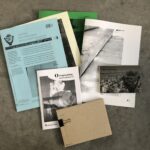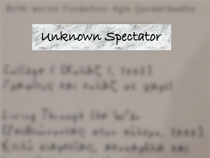Learning from the Poisoned Gift
Roger Sansi
Learning from Documenta is probably one of the most comprehensive attempts to unfold an ethnography of contemporary art ever made. It is already quite remarkable in its ambition to cover an event of such dimensions as Documenta without any of its resources. But Learning from Documenta is even more extraordinary in its multiple outcomes, which offer a sharp, critical analysis not only of its object of study, Documenta, but of contemporary art in general and its relation to Anthropology. Several questions arise.
The first question has to do with the mirroring effect: Learning from Documenta (LfD) mirrors Learning from Athens (LfA), making ethnography out of its multiple projects. But the relation between the art projects in LfA and its mirror image in LfD took different forms. Some of the researchers in this section worked very closely with the artists, some others worked from a conflictual distance—for example, when they were stopped from filming by the Documenta team. These different examples show the multiple effects that this mirroring can have. On the other hand, these entanglements took different forms, from a more conventional ethnography to visual anthropology and walking and mapping workshops, that in many ways mimic the work of artists. At the same time that anthropologists do ethnography on artists doing ethnography, they also make films and walks and mapping workshops, like artists do, in processes of mutual appropriation that sometimes are difficult to disentangle.
The multiple forms of engagement lead to a second question, the parasite. The mirroring effect of LfD is in itself a questioning of the “site.” What was Athens for LfA? Eva Fotiadi´s text is particularly enlightening in this respect. On the one hand, Athens was a specific place to be visited, to be learned from, and hence a place of alterity that was exoticized; on the other hand, it was a token of a type, one example of the negative effects of neoliberalism, and the possibility of bringing forth an alternative. According to Fotiadi, the first approach is what received most of the critiques, despite the Documenta team’s stated emphasis on the second. And yet in its realization, as Fotiadi also says, the distinction between the first and the second approach to the site was not so clear. Turning the question around, LfD adddresses LfA as a “site” to be researched. But the relation with the site was problematic, shifting from open collaboration to shadowing. The question of the “parasite”[1] inevitably comes to the fore: it identifies a site that cannot be represented by a single authoritative voice, one where multiple, divergent agencies interact across geographic, temporal, and disciplinary boundaries, like the “assemblage” described by one of the authors in this section. In this context, the ethnographer is both inside and outside, in an unstable position. This instability leads to the second, more common notion of the parasite, as an uninvited guest, a freeloader. But who is the uninvited guest here? The researchers of LfD or the artists of LfA? These questions have to include the variable that often the researchers of LfD have more claims to being “native” than the artists. And this conundrum takes me to the next question: the gift.
The delocalization of Documenta from Germany to Athens presented itself as a generous offer, a “gift” to the city and to Greece. But many “native” voices questioned LfA as a colonialist project, which, with culture, tried to compensate for the damage that had been inflicted upon Greece through the structural adjustment programs of the EU (a shorthand for Germany) after the sovereign debt crisis of the previous years. Moreover, it was said the organisation of Documenta did not collaborate thoroughly with the whole local artistic community, but instead mostly imported international art projects that related to Athens as a “site,” sometimes very superficially, often falling back on the usual topics surrounding the city and Greece, from the Ancient Civilization to the already mentioned economic crisis and anarchist insurgency. Who was giving the gift to whom? Who was the parasite? This was an ongoing discussion during LfA. And of course, this question is no stranger to anthropologists, who have been working on gifts for a long time. Gift giving in art contexts commonly appears as a voluntary and free act of generosity between equals. It is often claimed as an alternative to commodity exchange and capitalism.[2] But anthropology has shown that gift giving involves the production and reproduction of hierarchies. That gifts entail obligations. Moreover, gifts blur the boundaries between subjects and agents of exchange. Sometimes it is not clear who is who anymore, and even worse, it is not clear who started the process.
LfA offered itself as an “antidote,”[3] a remedy to the maladies of Athens. But what was ailing? Was the antidote a cure or a poison? The ambiguous gift appears as a “pharmakon,” both remedy and poison (another ancient Greek concept that has been “borrowed by” or “given to” contemporary thought, depending on the point of view). And yet, poisoned gifts often make exceptionally interesting ethnographic objects, “traps” of agencies, parasitical assemblages to learn from, like LfA/LfD.
Roger Sansi was born in Barcelona, Spain, in 1972. After studying at the Universities of Barcelona and Paris he received his PhD in Anthropology at the University of Chicago (2003). He has taught at Goldsmiths College, University of London. Currently he his Professor in Social Anthropology at Universitat de Barcelona, Spain. He has worked on Afro-Brazilian culture and religion, the concept of the fetish, and on contemporary art in Barcelona. His publications include the books Fetishes and Monuments (Berghahn, 2007), Sorcery in the Black Atlantic (edited with L. Nicolau, Chicago UP 2011), Art Anthropology and the Gift (Bloomsbury 2015), and The Anthropologist as Curator ( Bloosmbury 2019) .
Notes
[1] G.E. Marcus, ed., Para-sites: A Casebook against Cynical Reason, vol. 7 (Chicago: University of Chicago Press, 2000).
[2] Roger Sansi, Art, Anthropology and the Gift (London: Bloomsbury, 2015).
[3] Paul Preciado, “The Apatride Exhibitions,” e-flux conversations (2017). https://conversations.e-flux.com/t/paul-b-preciado-the-apatride-exhibition/6392











